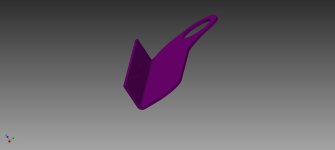notger
100 W
- Joined
- Mar 14, 2013
- Messages
- 279
Hi there.
until now i was using mostly steel sheets for my project.
but for the next on id like to take some aluminium.
id like to bend 3mm 7075 T6 aluminium sheets by 90 degrees.
i know i could read bending radius from charts but id like to hear some real experiences.
does anyone know what would be a realistic minimal radius for 3mm aluminium sheets?
Without weakening the material too much.
or would "normal " 7075 be easier or better to ben and still stiff enough?
its about this part....

thanks in advance
Gernot
until now i was using mostly steel sheets for my project.
but for the next on id like to take some aluminium.
id like to bend 3mm 7075 T6 aluminium sheets by 90 degrees.
i know i could read bending radius from charts but id like to hear some real experiences.
does anyone know what would be a realistic minimal radius for 3mm aluminium sheets?
Without weakening the material too much.
or would "normal " 7075 be easier or better to ben and still stiff enough?
its about this part....

thanks in advance
Gernot

